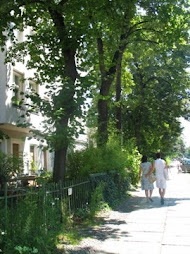Last Friday I went to a commemoration of the victims of the Nazi 'Euthanasia' programme. Between 1933 and 1945 around 200,000 physically disabled, mentally handicapped, mentally ill and old people were killed through injections, tablets, shooting, lack of care and gassing. The latter medium of death was in six different places in Germany and Austria which alone were responsible for over 70,000 deaths between 1939 and 1941, in gas chambers that served as testing stations for the gas chambers that would later be set up to kill Jews, Roma and Sinti.
Since visiting the memorial site for one of those killing stations in Hartheim, just north of Linz in Austria when I was a volunteer in Dachau, I have taken a great interest in this area. This has been renewed since moving to Berlin and visiting the clinic in Wittenau in the north of Berlin, which was used as a transit point for people about to be sent off to be killed elsewhere, as well as being a place where sterilisation took place and also the killing through tablets of mentally ill people.
The 'T4' office, which refers to the address where it was (Tiergartenstraße 4) , where the above memorial was put. Now the Berlin Philharmonic building is to be found there. That is where a function was given to go along with the placing of the 'grey bus' in its place. Grey buses were, you see, used to transport those destined to be killed. The words 'where are you taking us' are inscribed within the memorial.
I have been to many such functions now and am not the biggest fan of them, but the speeches given were very good. Normally speeches by public officials are kind of political propaganda, but ones from Baden-Württemburg were impassioned, informing us of what happened in the killing centre in Grafenek. Another speech I liked was given by the vice-president of the German parliament, who is SDP, who spoke of the fact that all victim groups need to be commemorated, and that slowly this is happening.
As I was listening to all this, however, I was thinking that the speeches being given were done from the side of those in authority. As good as those speeches were, the side of the victims were missing. Various institutions that work with the psychically disabled and mentally ill were part of the body that organised the placing of the 'grey bus' in Berlin, but no-one from them were given a speech.
It did happen though. Sigrid Falkenstein, a woman in her 50's, spoke of Anna Lehnkering, who was her auntie. Anna was someone of a 'simple disposition' who, in 1936 when she was 24 years old, was forced into a clinic in the Rheinland. A doctor had previously investigated her and labelled her as a 'burden'. Four days after her arrival in the clinic she was sent to Grafenik, and died within the same day she arrived. The official cause of death was 'peritonitis'. Actually, she had been gassed.
Her death was not spoken about in the family for decades. Sigrid had two older brothers who remembered her, and simply spoke of the shame they felt for having such a sister, who would today probably be called someone with 'learning difficulties'. Other than that, no-one spoke about her, and about her death. Then one day Sigrid was on the internet looking into the victims of the 'Euthanasia' programme and she came across her aunty's name. That is how she learned how she died. Sigrid got involved with various bodies campaigning for more recognition in Germany, and was part of the group who installed the 'grey bus' in Berlin.
For me, this story shows something quite typical in Germany: many absences have been repressed and it took decades before people spoke of them. Eventually a memorial site to the victims of the 'Euthanasia' programme will be built in Tiergartenstraße 4. Otherwise a memorial site to the victims of 'Euthanasia' is in Wittenau, a place where I did a tour for Action Reconciliation Service for Peace last year. If you want more information then let me know.

